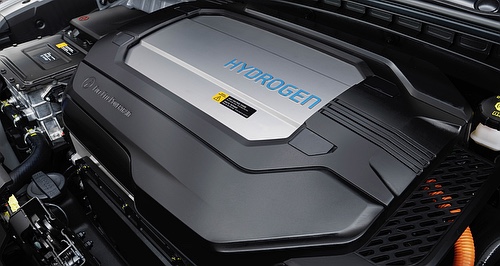Make / Model Search
News - General News - EmissionsCalifornian rule change may derail hydrogen ICEsUS state to oppose ‘hot hydrogen’ tech, threatens carbon-free route for many OEMs12 Jul 2024 By MATT BROGAN SO-CALLED ‘hot hydrogen’, or hydrogen internal combustion engine technology, must prove it can meet California’s strict incoming emissions regulations if it is to succeed in the US market.
OEMs are seeking to utilise hot hydrogen technology to leverage existing engines, which can be modified cheaply to operate “emissions free”.
The technology has the potential to save car manufacturers hundreds of millions of dollars in new energy vehicle development costs while at the same time capitalising on existing parts supply chains.
Toyota, Honda, and others are exploring hot hydrogen technology in passenger and light commercial vehicle applications, while heavy commercial vehicle manufacturers are trialling hydrogen internal combustion engine technology in everything from construction equipment to logistics handling vehicles, trucks, buses, and even golf carts.
One advantage of the technology is the number of common parts with ICE engines, and the large population of technicians already able to maintain and repair the units, as Cummins director of global regulatory affairs Tom Swenson explains.
“Conventional internal combustion engines that run on gasoline (petrol), diesel, and natural gas can be adapted to run on hydrogen fuel, which has the potential to reduce tailpipe CO2 emissions by over 99 per cent,” he said.
California, which often influences the uptake of new energy vehicle technology elsewhere (at least 15 other US states have adopted Californian legislation previously), has banned the sale of new internal combustion engine powered vehicles from 2035.
The concern is understood to relate to the production of NOx emissions and hydrocarbons still produced by hot hydrogen technology, albeit in far smaller quantities, as well as the sourcing of so-called ‘clean’ or ‘green’ renewably sourced hydrogen.
In a recent workshop held by the California Air Resources Board (CARB), the hot hydrogen was labelled a “dead end technology” with one analyst calling H2-ICE “terribly inefficient”.
“From a climate perspective, hydrogen’s reliance on natural gas as a source means massive emissions upstream of the truck thanks to fugitive methane emissions,” said Union of Concerned Scientists senior vehicles analyst Dave Cooke noting research from the Argonne National Laboratory.
“But from a public health perspective, the ubiquity of fossil hydrogen means that you are simply replacing the harms of one fossil fuel with another.
“All of the industrial pollution associated with the production and distribution of natural gas yields massive amounts of pollution, and then you combine that with the emissions related to the reforming process to actually turn that gas into hydrogen.
“And then all of these polluting steps are compounded by the fact that you’re just burning the fuel, which is just terribly inefficient.”
The news comes just a week after BMW general project manager of hydrogen technology and vehicle project Dr Juergen Guldner told GoAuto that the Bavarian manufacturer had “given up on the technology years ago”.
“We actually started with hydrogen combustions with a project called Hydrogen 7 almost 20 years back, and we actually stopped that because of the lack of efficiency,” he explained.
“Basically, with the X5 Hydrogen FCEV we get around 500km from a fill. If I put a combustion engine in the same car with the same tank, I wouldn’t even get 300km. That is the difference between a product we can sell, and a product we cannot sell.”
 Read more8th of July 2024  BMW gave up on hot hydrogen ‘years ago’Efficiency of hydrogen combustion engines unsuitable for passenger vehicles, says BMW18th of June 2024  Hydrogen HiLux reaches final test phaseFinal testing phase for hydrogen fuel cell HiLux with real-world trials underway |
Click to shareGeneral News articlesResearch General News Motor industry news |











Facebook Twitter Instagram